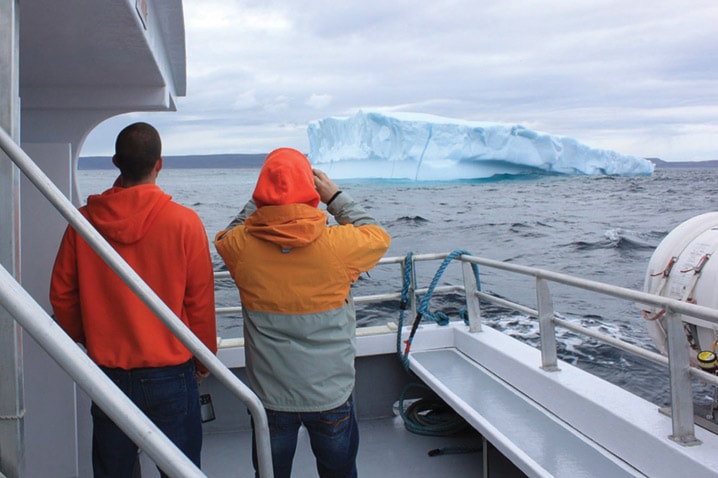ST. JOHN’S, N.L. — Six weeks after the 100th anniversary of the Titanic disaster showcased Iceberg Alley off Newfoundland, an early and plentiful show of the glacial sculptures is drawing visitors from around the world.
Tourists from Japan, South Africa, Europe, the U.S. and across Canada are lining up for their chance to admire these mammoth relics from the last ice age. Huge white and aqua blue blocks carved by wind and waves into towering pillars, contoured slabs and smooth Henry Moore-like shapes now dot the province’s coastlines.
Capt. Barry Rogers, co-owner and operator of Iceberg Quest Ocean Tours with his wife Carol Anne Hayes, says it has already been the best iceberg viewing season off St. John’s in recent years.
“Normally our season is the latter part of May and June. We’ve been doing iceberg tours since May 9, and with full boats,” he said of the vessel that’s equipped with a life raft for 75 people along with personal flotation devices. It typically carries between about 30 and 50 passengers, he said.
On a recent tour Rogers steered the boat through St. John’s Harbour, past the colourful clapboard houses of the Battery that hug Signal Hill, through the Narrows and out into the open North Atlantic. Cruising at about eight knots past Cape Spear’s iconic flashing lighthouse, the most easterly point of North America, it wasn’t long before we started seeing relatively small but hazardous hunks of ice or “bergy bits” in the water.
These rock-hard blocks of ice are feared by mariners for their ability to slice even the strongest hull like a can opener. Rogers said bergy bits are a major reason why he avoids night trips at this time of year.
Melting pieces of ice less than five metres long are called “growlers” for the sounds they make “like a saucy dog” as they release air, he added.
A bit farther out, the boat’s radar picked up something that we soon saw rising up from the water ahead of us. It was a tabular iceberg, about 90 metres long and 45 metres wide, flat on the surface where icy dust was visible alongside deepening crevices and cracks. Meltwater rushed off in places like small rivers.
“Awesome!” was the response from several passengers as Rogers asked what they thought.
“We’re looking at 600 to 700 feet of water underneath us right now,” the captain said, urging them to envision that 90 per cent of the berg’s mass is submerged.
Rogers described over a microphone how the big slab likely split from glaciers that cover much of Greenland. They form a thick ice coating that creeps down hills and ridges, breaking off with a booming crash as it reaches the sea. Resulting bergs are believed to be at least 12,000-year-old frozen samples of some of the purest water on earth. They float because they’re less dense than sea water.
Tourists are especially fascinated with icebergs because of Titanic and a surging interest in Newfoundland and Labrador thanks to a hit advertising campaign, Rogers said. The International Ice Patrol, formed after a relatively small berg sank the great ship on April 15, 1912, to this day reports the movement of sea ice for those navigating these dangerous waters.
“The biggest one I’ve seen and worked with, it took me around 35 minutes to steam around it,” Rogers said. “It was around 1.5 kilometres long.
“Every trip that we go out, they have a different shape to them. The contours are different. They could be a tabular type — the flat ones that you could probably land a big plane on — or they could be pillar types with beautiful spirals going up. And then you get the dry-dock ones, we call them, with a pool in the centre. In the sunlight, they’re just magnificent colours and folks love that.”
One crew member armed with a large fishing net captured a chunk of ice to chip into prehistoric cocktails.
“We sprinkle rum over the 12,000-year-old ice,” Rogers said. “Where else would you get to consume something that’s from the ice ages?”
If you go:
Iceberg Quest Ocean Tours with locations in St. John’s, N.L. and Twillingate, N.L.: www.icebergquest.com or 1-709-722-1888.
Northland Discovery Boat Tours, St. Anthony, N.L.: www.discovernorthland.com or 1-877-632-3747.
Iceberg tracker information: www.icebergfinder.com
